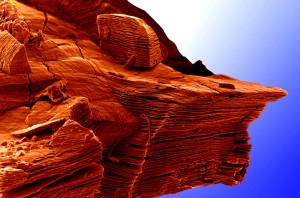A group of Drexel engineers won the “People’s Choice” award for their photograph titled “The Cliff of the Two-Dimensional World” in the ninth annual National Science Foundation Visualization Challenge, the organization announced Feb. 2.
Babak Anasori and Michael Naguib, both doctoral students, worked with professors Yury Gogotsi and Michel Barsoum of the materials science and engineering department to create the winning image. Barsoum Gogotsi initially recommended that the team enter the 2011 International Science and Engineering Visualization Challenge, and event co-held with the journal “Science.”
The photo was taken of Naguib’s research on nanosheets made from ultrathin layers of titanium-based compounds that can be used to store a charge in a lithium-ion battery and other energy storage devices. At first glance, the award-winning photo looks like a bright red rock bluff landscape, but the layers of the “rock” are actually nanosheets so thin that they can be considered two-dimensional.
“You have to use the image to explain the science and attract the general audience,” Anasori said. “When you apply [to the competition, you] have to explain why it is important and in a way people can understand it.”
Anasori and Naguib named these layers MXenes after Naguib fabricated them with a compound of titanium and carbon. MXenes can be used to produce energy storage in devices such as sensors and solar cells. When they are viewed under an electron microscope, as they were when the picture was taken, Anasori noticed that they resembled rocky edges.
“When you zoom in 20,000 times, you can see unique things,” he said.
According to Anasori, all of the pictures were initially in black and white. Although he spent only an hour adding color to the image, he spent weeks adjusting it.Although Anasori and his team did not receive any award from the NSF for their win, they considered their publication in “Science” magazine rewarding, calling it the “top competition” for scientific photography.
This was the first year that the NSF challenge allowed participants to submit their entries online. This was also the first time that individuals could select favorite images as “People’s Choice” candidates as part of the voting process. Cumulatively, the entries received 3,204 public votes. Also for the first time, the NSF allowed participants and the public to use social media websites to share their favorite entries with others.
The categories of competition were for video, interactive games, illustration, photography, and informational posters and graphics. Each of these categories named a first place, honorable mention and “People’s Choice” winner. The NSF received 212 entries from 33 countries, with participants representing all six inhabited continents.
Anasori was informed by email Oct.24 that his photo was in the top 10 list of finalists and that the competition was open to public voting for only four days. He then contacted influential members of the Drexel community, including Antonios Zavaliangos, head of the materials science and engineering department, President John A. Fry and Provost Mark Greenberg, to inform them of the competition and to gain support in order to accumulate votes.
“We had a pretty big jump in votes, so it was great to have the support from Drexel,” he said.
Another image of Anasori’s that has placed in competitions is called “MAX Dragon,” which shows a fractured surface of nanocrystalline magnesium from his own research, colored to depict a fire-breathing dragon.
Referring to the image, he said, “Drexel inspired me to see it. When you are in Drexel, you see dragons everywhere.”
This image gave Anasori the idea to begin entering competitions when it placed among top finalists in the NSF competition last year. This image was also named “Image of the Month” in the 2011 International Metallographic Contest on the ASM International Metallography Society website and was a winner in the 2010 CRF image competition
The winning entries of the 2011 NSF competition can be viewed at nsf.com, sciencemag.org and in the Feb. 3 print issue of “Science.”


